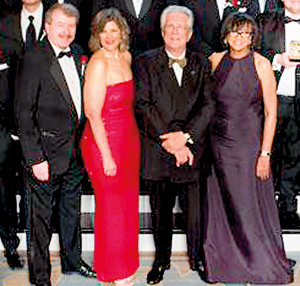Sunday Times 2
The invisible star

The SMPTE team at the award ceremony.
The ever present star of movies for over ten decades was never to be seen. Like the movie magic which was generated through that stars contribution, the presence was to be experienced yet visible in each movie image.
There was no fan mail, adulation, swooning fans.
Yet a ‘star’ it was.
Some star.
That star made possible each and every movie, Hollywood and beyond, including the Soviet era since 1916.
Made up in 64 Countries, 6,000 members strong and responsible for 800 motion picture and television standards, which make movie making and presentation possible all over the world.
Founded in 1916 by Francis Jenkins to make sense of the chaos of 25 odd film standards at that time, the Society of Motion Picture Engineers has been in the forefront of every movie and later, as the Society of Motion Picture and Television Engineers of today’s television production and transmission, a result of the standardisation made possible by the SMPTE (‘semptee’ as it is fondly called).
As the Academy Awards celebrated 88 years with an all-white cast of characters, and a Best Film award to pedophile theme, the ‘invisible star’ was also celebrated and honored at a special ceremony.
That visibly unobtrusive yet invisible 100 year presence and contribution was celebrated during the Academy Awards when a special Academy Award was presented to the SMPTE to a standing ovation, for “one hundred nurturing technology, providing essential standards offering expertise and support, tools and infrastructure for the creation and production of motion pictures, and later television”.
In 1957, Bette Davis presented the SMPTE’s first Oscar, followed by the second Oscar in 1989.
But this third time Oscar comes in the Centennial Year of the SMPTE. A fitting tribute to the vital work SMPTE has been doing to advance motion picture and television industries the world over from Montana to Mongolia to Moscow.
Have you ever seen the color bars television test pattern? Watched a live sports broadcast, or a movie in 3D or a digitally projected movie? Then you’ve most likely seen the Oscar Award-winning SMPTE in action!
SMPTE standards touch nearly every piece of motion-imaging content consumed by billions of viewers around the world, ensuring that content is seen and heard in the highest possible quality on any display screen. SMPTE standards also enable repeatable workflows and profitable business models for content creators and distributors, as well as the manufacturers who support them.
Since its founding in 1916, SMPTE has developed more than 800 standards (ST), recommended practices (RP), and engineering guidelines (EG), and it continues to innovate at a rapid clip, generating an average of 50 new standards annually focused on film and digital cinema, television, and internet video. The digital cinema revolution which has resulted in 80% of the world’s cinemas to go digital is based on many SMPTE standards.
By providing structure, organization, and interoperability, SMPTE has helped advance the motion-imaging industry through all of the major transitions, from the advent and integration of sound and color to the shift from celluloid and analog to digital formats, including digital cinema (DCI), high-definition television (HDTV), and 3D TV.
In addition to thousands of individual professionals globally, more than 220 organizations from around the world support SMPTE, with sustaining members representing leaders across the media and entertainment industry.
Seemingly uninteresting stuff, to all but dedicated cinemagoers.
Still, that is the “invisible” stuff which makes each and every cinema goer enjoy a movie and television magic made possible by SMPTE for a century, the world over.
(The writer is a Life Fellow of the Society of Motion Picture and Television Engineers.)

